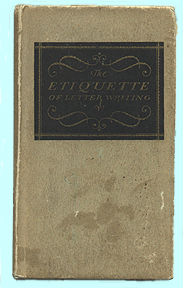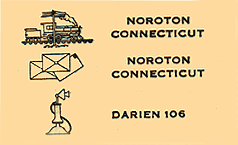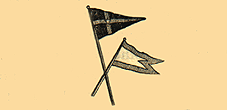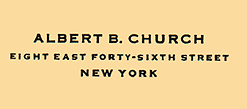
From Eaton, Crane & Pike Company's The Etiquette of Letter Writing, (1927 edition):
2. SOCIAL STATIONERY
The letters we write our friends are governed by rules permitting more personal expression than formerly - for a letter today that does not breathe the personality of the sender is surely a dull thing, but fine thought it may be, there is none the less a definite line which very clearly divides an expression of personality from an indulgence of egotism.
The delicate grey envelope and the finely wrought silver monogram may be as indicative of the charm of the correspondent as her fine hand writing and her subtly expressed thoughts - and the rugged character of another may as well be complimented by his choice of strong large sheets with a simple block letter die; but the strange color of ink and paper headed by too prominent a cabalistic sign of the third unfortunately means but one thing, bad taste.
It is the accepted custom in most well bred homes today to have at least three types of writing paper, a flat sheet for the man, a good grade of folded paper for everyday correspondence and a paper of recognized superiority for "state occasions."
Sizes of Paper and Their Uses
Many people seem puzzled as to when it is correct to use large-size note paper, small note paper, and the popular correspondence card.
For notes, Woodlea (4-7/16 x 5-1/8 inches) seems to be a preference.
For a woman's general correspondence Edith (5-3/8 x 6-13/16) is a good standard to use. For those who write a firm, large hand, or whose personality seems to require something a little more striking, Orleans (5-13/16 x 7-3/4) is a better size and unquestionably more effective.
For the correspondence card, Edith (3-3/8 x 5-3/8) is the size in general use for a small card, while the Orleans (3-7/8 x 5-13/16 inches) is likely to be the choice of the woman who prefers large-size note paper.
These approved sizes of note paper and correspondence cards may be embellished with a monogram or crest, placed generally in the upper left-hand corner. Some women prefer, for general use, the address alone and this is apt to be stamped today in a rather plain style of letter.
The color of stamping varies with the delicate tint of the stationery. Dark blue, green and grey are favored tints; plain white or self-tint embossing is well-liked, and white on grey most effective. In the case of the medallion type of monogram, one or two colors, such as silver and dark blue, are frequently used together. "Cut-out" monograms are stamped in gold or silver in combination with one or two or sometimes three colors. Any oddities of an extreme character are frowned upon by convention, although one may express individuality in the size and style of the die and the color of the stamping.
Country House Stationery
In stationery for country house use, one is permitted the same indulgence that pertains to country life in general - a little ease, a little gaiety, a letting down of punctilious formality.
Thus a woman whose formal stationery breathes the very spirit of conventionality may quite correctly choose a grey paper with her country address engraved in vermillion if that color scheme suits her personality and the spirit of her house.

This paper often bears the necessary telegraph, train and telephone addresses arranged in the upper left-hand corner in the following fashion, which is at once explicit and amusing:
The name of the country place or estate, and the post office address, as:
GREENACRES
NOROTON, CONNECTICUT
are then so placed in the upper right-hand corner to balance this little group. The same arrangement may be followed on the correspondence cards.
Yacht Stationary

Stationery for use on board a yacht bears the name of the yacht (sometimes preceded by the words On Board) in plain lettering in the upper right-hand corner and a die-stamped reproduction of the owner's flag, in the appropriate colors, in the upper left corner. The club flag should be shown above the owner's flag, as illustrated:
Some yachtsmen use two club flags and their own private flag. (*)
Men's Stationary
For general correspondence, men use a plain white paper of a size such as Orleans or Lyleton. They do not use a monogram, merely initials, stamped in the top center of the sheet in heavy block type, or an address die.
Both the initials and the address are sometimes used, either in the center or in the upper left and right corners, the initials being placed in the left corner, of course.

For semi-business correspondence, men frequently use double note paper of a size such as Club Letters (6-1/2 x 7-1/4) or a flat single sheet, sometimes called a "two fold single" sheet (7-1/4 x 10-3/8) with the name and address stamped in block letters somewhat after the fashion of the following:
A man who lives at his club or uses it quite frequently, writes on its stationery.
In the past, comparatively few men have used correspondence cards, seeming to prefer correspondence paper of medium size for acceptances, regrets, or other short notes. However, on the writing tables of some of the prominent men's clubs are now found heavy cards of generous size, generally in the coarser finishes (Vellum or old-style effects), with the club insignia in the upper left corner, or the club name, or merely the club street address, in the center at the top of the card.
Travel Stationery
Perhaps it is the extent of present day travel that has increased the use of those thin types of paper formerly called "foreign correspondence paper" (not because they came from Europe or were made there but because their thin quality made them the only possible choice for the thick letters to the far off correspondent).
Today since one has so many friends who are far afield and letters to them are the only means of communication, this type of paper has grown very popular and there is no doubt that the gay and amusing colored linings of the envelopes , with the possibilities they afford of interesting color combinations in monogram dies, has done much to stimulate its use.
Business Stationery
Business stationery has reached a very high standard of excellence today. The finest specimens are die-stamped or plate printed, with a well-balanced arrangement of address, telephone number and any other necessary information. A large single sheet (8-1/2 x 11 inches) of a medium weight is generally chosen for the typewritten letter of length, while a sheet 6-1/4 x 7 inches is often used for the shorter typed note or that written by hand. White or light greay paper is perhaps the best choice, although cream color or light beige shades are sometimes used. The die-stamping may be in grey or any dark tone, such as blue, green, plum, or black. Gold or silver are not suited to this purpose.
The name of the individual or firm and the address may appear either in the upper left-hand corner of the envelope, or on the flap, as preferred.
Engraved announcements are now sent by most of the better shops to acquaint their customers with the opening of a department, the arrival of important merchandise, or a change in the personnel of the department. These announcements may be on cards or on double note paper.
Such announcements are used by lawyers, bankers, doctors and professional men in general to announce a change in the personnel of the firm. They usually take a form somewhat as follows:
Fenwick and Haskell, Architects
take pleasure in announcing that Mr. B. H. Stowell,
Mr. William T. Larabee and Mr. Thomas E. Blade
will in the future be associated with this
office in the practice of architecture under the
firm name of
Fenwick and Haskell, Architects
Stowell, Larabee and Blade, Associated
52 Amsterdam Avenue
January 1, 1927
Such announcements may be engraved in any of the approved styles of lettering.
(*) (Ed. note: readers may wish to consult with their own yacht club or clubs as to the appropriate display on banners or insignia.)
OTHER TOPICS


Slipcue Mail Bag
Press Clippings & Print Reviews
